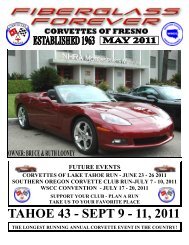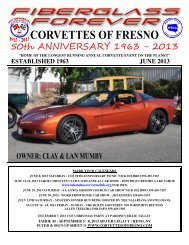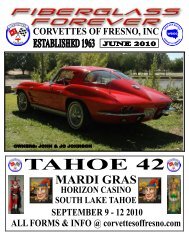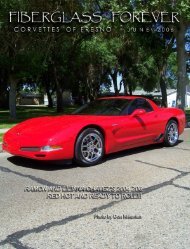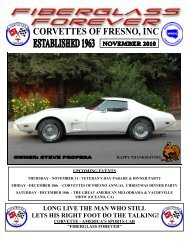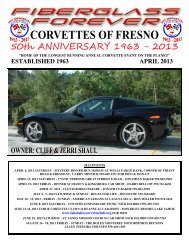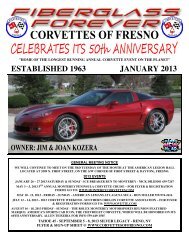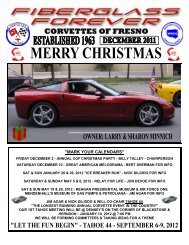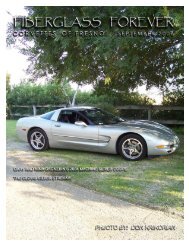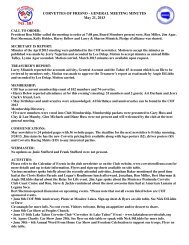Download
Download
Download
Create successful ePaper yourself
Turn your PDF publications into a flip-book with our unique Google optimized e-Paper software.
12.6-inch (320 mm) front rotors and 13.3-inch (338 mm) rear rotors are standard and<br />
have 35 percent more swept area than previous-generation brakes. Consequently<br />
stopping distance is improved 9 percent<br />
Dual-cast, slotted 13.6-inch (345 mm) front rotors and 13.3-inch (338 mm) slotted rear<br />
rotors are included with Z51 Performance Package. They have 6percent more swept<br />
area than the previous-generation Grand Sport and are cooled front and rear for<br />
improved track capability. Consequently stopping distance is improved 5 percent<br />
All brake packages have fixed front and rear calipers are stiffer for more even pad wear,<br />
reduced drag and improved modulation.<br />
The Technologically Advanced 2014 Corvette Stingray<br />
The 2014 Chevrolet Corvette Stingray has<br />
definitely come a long way since the EX-122<br />
Corvette Prototype that was unveiled in New<br />
York City almost 60 years ago.<br />
High-tech features abound on the C7 Corvette,<br />
but Chevrolet engineers are quick to point out<br />
that the modern amenities on their newest<br />
creation revealed today aren’t just technology<br />
for the sake of having technology. They help the<br />
car offer more performance, enhanced driving<br />
experience, and more efficiency.<br />
“The all-new Corvette Stingray is really three cars in one: It provides the comfort and functionality of a<br />
long-distance GT car, the connectedness and infotainment of a daily driver and the acceleration, grip and<br />
braking of a capable track car,” says Harlan Charles, product manager.<br />
For example, the Driver Mode Selector allows the<br />
driver to make every aspect of the car fit their own<br />
driving environment. A rotary knob near the shifter<br />
controls the DMS, which features five positions<br />
(Tour, Weather, Eco, Sport, and Track) to control<br />
12 vehicle attributes depending on the situation the<br />
driver finds himself in.<br />
“The result is a more rewarding, more confident<br />
experience,” Charles says, “whether you’re<br />
commuting in a downpour or charging through the<br />
corkscrew at Laguna Seca.”<br />
With each twist of the DMS, 12 performance categories are adjusted, including gauge cluster<br />
configuration, electronic throttle control (for improved responsiveness), paddle-shift automatic<br />
transmission, active fuel management (allowing either four cylinders or eight cylinders to be used for<br />
improved fuel economy), active exhaust system, electronic limited-slip differential, steering assist effort,<br />
magnetic ride control, launch control, active handling, traction control, and performance traction<br />
management.



